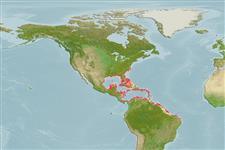Actinopterygii (ray-finned fishes) >
Perciformes (Perch-likes) >
Eleotridae (Sleepers) > Eleotrinae
Etymology: Dormitator: Latin, dormire = to sleep (Ref. 45335).
Environment / Climate / Range
Ecology
Marine; freshwater; brackish; demersal; amphidromous (Ref. 51243). Tropical; 17°C - 35°C (Ref. 35237), preferred ?; 37°N - 5°S
North to South America: along the Atlantic slope from North Carolina (USA) to southeastern Brazil.
Size / Weight / Age
Maturity: Lm ? range ? - ? cm
Max length : 70.0 cm TL male/unsexed; (Ref. 26340); common length : 14.5 cm TL male/unsexed; (Ref. 12193)
Adults inhabit marshes, muddy ponds and channels with a salinity range of 0 to 21 ppt (Ref. 7251), up to 38.4 ppt in some cases (Ref. 97140). Mostly found in fresh water but also in brackish mangrove areas. They ascend upstream but remain in the lower reaches. Sexually mature after one year. Gonads develop during the dry season. Average size at maturity is 5.1 cm for males, 4.5 cm for females. Omnivorous, adults feed mainly on plants, sediments and invertebrates. They undergo coloration change during reproduction, carrying out a complex nuptial parade. Adults guard the nest. Egg is 0.3 mm, incubation time is 11 to 16 hours at 27°C (Ref. 35237).
Life cycle and mating behavior
Maturity | Reproduction | Spawning | Eggs | Fecundity | Larvae
Robins, C.R. and G.C. Ray, 1986. A field guide to Atlantic coast fishes of North America. Houghton Mifflin Company, Boston, U.S.A. 354 p. (Ref. 7251)
IUCN Red List Status (Ref. 115185)
CITES (Ref. 94142)
Not Evaluated
Threat to humans
Harmless
Human uses
Aquarium: commercial
Tools
Special reports
Download XML
Internet sources
